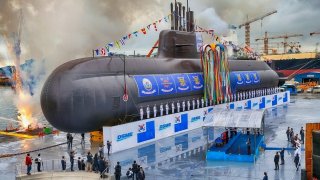South Korea Is Slowly Becoming a Submarine Superpower
The Republic of Korea Navy (ROK Navy), or South Korea, continues to increase its submarine capabilities – a significant shift after years of having largely only midget subs.
South Korea Looks to Increase its Submarine Force - The Republic of Korea Navy (ROK Navy), or South Korea, continues to increase its submarine capabilities – a significant shift after years of having largely only midget subs.
The Korean Attack Submarine program has been an ongoing effort that began in the 1990s to deter hostile submarines and surface ships; protect friendly naval bases and seashore communications; and carry out reconnaissance missions.
The KSS program called for a total of 27 diesel-electric attack submarines.
Beginning in the early 1990s, the Republic of Korea (South Korea) acquired nine 1,200-ton Jang Bogo-class submarines in the first phase of the program, KSS-I, while in the second phase, the ROK Navy acquired an additional nine 1,800-ton Type 214 submarines equipped with Air-independent propulsion (AIP). Those Sohn Wonyil-class boats are capable of launching cruise missiles.
South Korea's: The KSS-III Submarines
As part of the third phase, KSS-III, Seoul has built the first two of the planned nine boats of the Dosan Ahn Changho – and these are capable of firing submarine-launched ballistic missiles (SLBM).
The KSS-III boats are significantly larger than South Korea's previous generation of German-designed KSS-II/Type 214 submarines. However, like the older KSS-II, the KSS-III class is powered by diesel-electric with supplemental AIP capabilities using fuel cell technology, which provides top speeds of 20 knots and extended underwater operations lasting as long as 20 days.
According to the U.S. Naval Institute, the Dosan Ahn Changho class is fitted with an innovative vertical launch system (VLS) above the sail. The VLS can carry six conventionally armed SLBMs for land attack. Reportedly named the Hyunmoo 4-4, the non-nuclear SLBMs have a range of 270 nautical miles and were successfully test-launched from the Dosan Ahn Changho in September 2021. The KSS-III submarines can reportedly carry advanced sensors and weapons, including bow, flank, and towed-array sonars and six 21-inch bow tubes for heavyweight torpedoes, such as the new Tiger Shark.
Contract Awarded For a Stealth Submarine
This month, Hanwha Ocean announced Wednesday the shipbuilding giant has signed a contract with the government agency Korea Research Institute for Defense Technology Planning and Advancement to develop a more capable "stealth submarine.
According to a report from UPI, the latest focus will be on developing a new degaussing device designed to cut down on the magnetic field generated by submarines so they can better avoid detection. The South Korean company is the only firm in the country to boast a full range of submarines, with its midsize vessels in commission under Korea's and Indonesia's navies.
"With the submarines being hidden under water, there has been less of an interest in their stealth technology than, for say, fighter jets. We feel, hence, that there is actually a big room for growth," a Hanwha Ocean official told UPI News Korea. "Our aim is to develop submarines equipped with the world's best stealth technology, an effort that will help us improve our leadership in the global maritime defense market, including the United States and Europe."
Hanwha Ocean was also awarded a 1.1 trillion won (US$845 million) contract to build a 3,600-ton submarine for the ROK Navy. The construction of the submarine is expected to be completed by 2029, with the deployment to the South Korean Navy expected in 2031 following two years of testing.
Going Nuclear?
In November, Admiral Kim Myung-soo, the nominee for the ROK Joint Chief of Staff claimed that South Korea needs to have nuclear submarine capabilities despite the ROK-U.S. nuclear agreement remains a political challenge to overcome. However, recent movements have shown that two major parties of Korea are calling for the revision of the agreement as to obtain nuclear submarine capabilities, NavalNews.com first reported.
"While those capabilities are needed, there are clear limitations as to what South Korea can do due to the current ROK-U.S. nuclear agreement restricts the use of nuclear materials in military use," Kim said.
As NavalNews also noted, it remains a question for South Korea to find a long-term nuclear fuel supplier for its potential K-SSN fleet. However, an SSN fleet could be the best way to monitor and more importantly, deter North Korea's suspicious submarine activities than deploying Korea's nuclear submarines.
Author Experience and Expertise
Peter Suciu is a Michigan-based writer. He has contributed to more than four dozen magazines, newspapers, and websites with over 3,200 published pieces over a twenty-year career in journalism. He regularly writes about military hardware, firearms history, cybersecurity, politics, and international affairs. Peter is also a Contributing Writer for Forbes and Clearance Jobs. You can follow him on Twitter: @PeterSuciu.
Image Credit: Creative Commons.


